Making Sure All Kids Can Access Books
Game Changer! Book Access for All Kids
By Donalyn Miller and Colby Sharp
(Scholastic, 2018 – Learn more)

“Books are my life!” I recently heard this comment from a first grader who was thrilled to finally be able to read books to herself. Her comment filled me with joy. I love to read and believe that nurturing readers is a gift we give them.
Moreover, because research shows that people who read tend to be more empathetic than those who don’t, it is a gift we give to society as a whole.

Anthologies, lesson sets, interventions, strategy instruction, guided groups, phonics, word study, and all of the other best laid plans of reading teachers will not work if they are not grounded in opportunities for real reading.
Well, I don’t have a magic wand, but I do have a great book to share. Game Changer! Book Access for All Kids by Donalyn Miller and Colby Sharp is a must-read. Its 10 short chapters are power-packed with research, stories, and strategies for supporting a rich reading life for every child. In the introduction the authors note that they hope the book will:
- Help all see the importance of meaningful book access for kids.
- Increase support for school and public libraries and librarians.
- Help “nurture children’s positive reading identities, reading engagement, and academic growth” (p.5).
- Increase access to diverse literature.
- Foster students’ independent reading habits.
- Help educators develop and maintain strong reading communities.
These are tall orders for a little book of less than 150 pages, but you know what? Sharp and Miller do it! The pages are full of testimony and quotes from prominent educators, links to online resources and videos of the authors, useful charts and graphs, and my favorite — highlighted text that helps focus the reader on the big ideas on each page.
I loved reading Game Changers! and came away more enthusiastic than ever about my role as a literacy ambassador charged with creating a lasting community passion for reading. I think if you read it, you will be too!
What You’ll Find Inside
Chapter 1: From Book Deserts to Book Floods – Tools for Transformation
This chapter helps readers see access to books as an equity issue. As an educator who has always believed teaching literacy to be an act of advocating for social justice, this chapter had me continually nodding my head. ALL students need access to quality literature, and it is within the reach of any school to make that happen. In addition to the ideas offered in the text for getting books in the hands of kids, I invite you to read about how my school developed and maintained a free bookstore that builds the home libraries of students in our community.
Chapter 2: School Libraries and Librarians – The Right of Every Child
Here you’ll find advocacy information about the impact of strong school libraries with certified librarians. The meat of the chapter offers strategies for collaboration between school libraries and classrooms.
Chapter 3: Classroom Libraries – A Living Breathing Reading Community
If you want to learn the ins and outs of developing and maintaining a successful classroom library (which, the authors emphatically state, is a non-negotiable if you want to develop a school with a strong reading culture), this is your chapter.
Chapter 4: Books of Their Own – The Power of Book Ownership
Books in school libraries and classrooms are not enough! Students who become passionate readers must experience the unparalleled joy of reading books they own. Strategies for getting low-cost (or even free) books into the hands of students are shared in abundance. One notable resource missing from the chapter is First Book Marketplace, where teachers can find low-cost books or even boxes of free books for Title 1 schools.
Chapter 5: On the Level – Some Truths About Text Leveling Systems
Okay, anyone who knows me or reads my Heart of the School blog, knows that this can be a touchy subject. I think that there can be too much fuss over whether to level or not level and that the rhetoric around the topic can quickly become filled with dogmatism that has no place in honest conversations about teaching and learning. I was THRILLED to find that NOT to be the case in this chapter. The focus was on the importance of lots of choice and lots of books as the two most important factors in developing independent readers.
Chapter 6: Cultural and Social Access to Books – The Need for Representation in Children’s Literature
Here you’ll find information, ideas, and strategies for helping students see themselves and the world in the books they read. The authors remind their readers that all children “deserve to see their experiences and their families reflected in the books they read” (p.74).
Chapter 7: Knowing Children’s and Young Adult Literature – The Key to Matching Readers With Books
The bottom line in this chapter? Educators, you have to also be readers! Sharp and Miller encourage wide reading of books that might interest the young readers in our care. Reserving daily time to read, finding good books and series, asking children for recommendations, and generally nurturing our own reading lives, especially as they relate to helping our students learn to and love to read, is essential.
Chapter 8: Dedicating Time for Reading at Home and School
In this chapter readers find the whats, whys, and hows for implementing and encouraging strong choice-based independent reading programs that flow from the school day right into our students’ home lives. My school, which is Title 1 designated for poverty, consistently scores in the top 5% of schools in Wisconsin. More important, there is no gap between our students of poverty and their more affluent peers. We are all good readers and writers. I’ve had many schools reach out to ask how we are so successful. I always say the same thing, “We let kids read. A lot.”
In our school every student enjoys a minimum of 30 minutes of free reading time each day. Most days, students have closer to an hour. Miller and Sharp confirm that lots and lots and lots of time for reading is a key to academic success and happiness.
Chapter 9: The Power of Choice – Supporting Independent Readers
“Supporting young readers in self-selecting their own books requires explicit modeling and teaching in how to locate, preview, and evaluate books” (p.110). This chapter offers information how to offer that support in the form of book talks, book passes, audio texts, routines for picking books, and more.
Chapter 10: Our Community of Readers – The Relationships Readers Need Every Day
This chapter sums up the book and implores readers to remember that if we really want our students to be strong and passionate readers, it will take all stakeholders to make it happen.
I loved Game Changer! Book Access for All Kids and felt there were pearls of wisdom and gems of ideas on every page. I began here by talking about the magic wand I wish I had. Well, if I did have it, I would use it to put a copy of this book in the hands of every educator. The message is that important and the writing is that good.
Rita Platt (@ritaplatt) is a National Board Certified Teacher with master’s degrees in reading, library, and leadership. Her experience includes teaching learners in remote Alaskan villages, inner cities, and rural communities. She currently is a school principal, teaches graduate courses for the Professional Development Institute and blogs at Heart of the School for MiddleWeb.


































